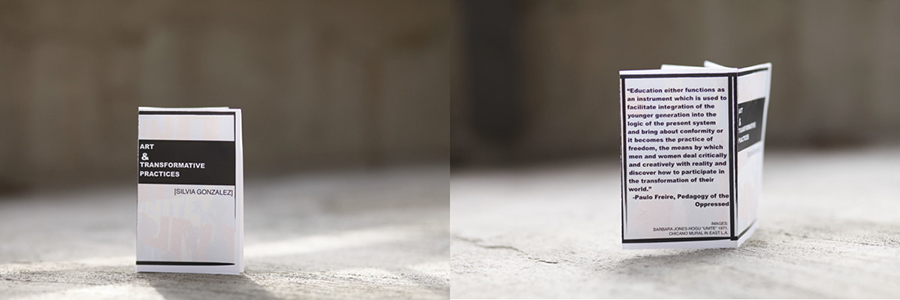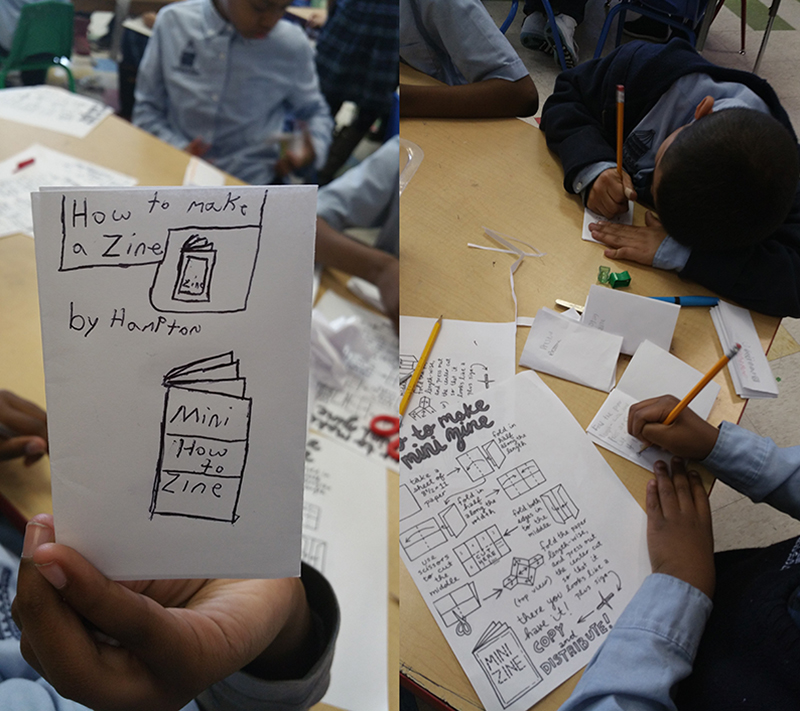
Art Like Me: A Culturally Relevant Contemporary Art History Workbook for Children is an art history workbook for elementary age students, pinpointing culturally relevant artists and artworks from diverse cultures. The workbook includes fun facts, artist biographies, in-depth looks into artworks, student-engaged projects to implement within the classroom, and a section used for student sketching and notetaking. This is a resource tool used to draw and reflect on artists and artworks of the 21st century, and can be adapted and expanded to as many diverse classrooms as possible!
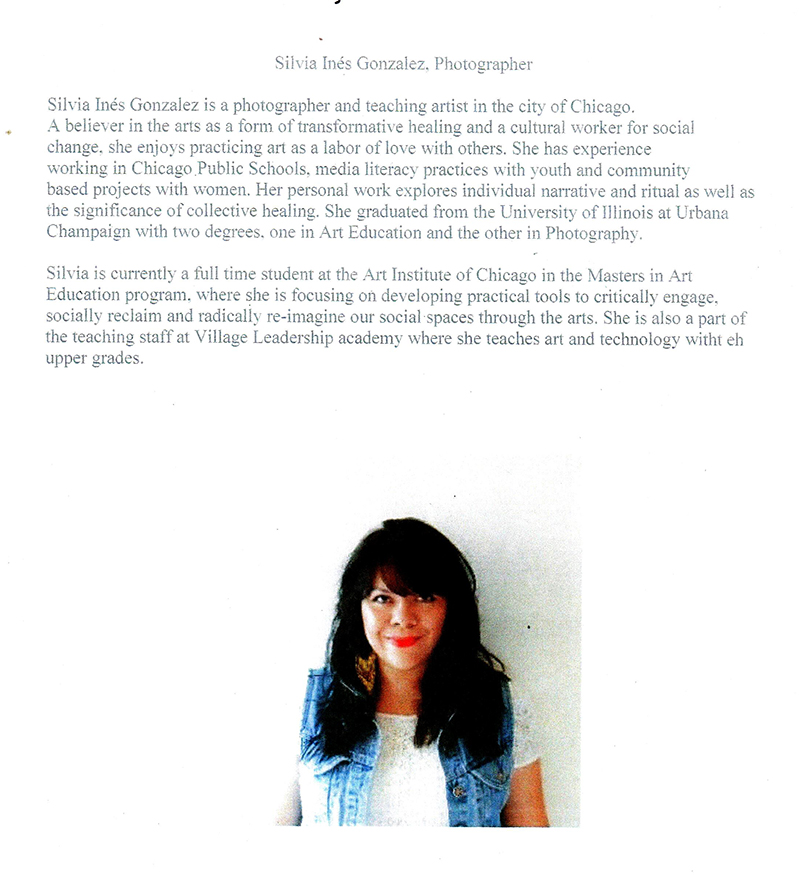
- Collaborate with students to create our own art history book that reflects them.
- Empower students to decide what kind of art history is important, and how we tell those stories.
- Expose students to a broad range of contemporary artists of color and female artists from diverse backgrounds.
Documentation + Assessment Suggestions
Here are some strategies to keep in mind from the steps above:
- Document your work by photocopying the really good Artist Booklet Worksheets.
- Document your work by taking pictures on project days. If this is a public book, you need parent permission to have pictures of their children within the booklet.
- Keep in mind: pictures of student’s classroom projects would be a great addition to your booklet, and should be used for documentation purposes.
Learning Activities
7 Steps to making an Art Like Me booklet in your classroom:
Working in dialogue with your students and the art community—
Step 1: Find your Artists.
The main purpose of this project is for students to make connections and culturally identify with contemporary artists and their artwork. What cultural identities does your student body represent? Whose work do your students need to see? The artists I choose may not be the ones that speak to you or your student population.
The artist selection process takes time, and may be subject to change. I chose artists I knew personally along with big-name artists to be a part of this project. Some artists will say yes, some say no, while others never respond back you. Your booklet has the potential to be stellar no matter who the artists are, just as long as you have artists.
Public or Private?
Is your booklet going to be distributed publicly? If so, then you’ll need to contact them, explain your project, and get permission to use their work inside your school’s booklet. You need to have artists sign an Artist Consent Form to use their work publicly.
Step 2: Create Artist Biographies Packets
What’s important about your artists’ lives, from the students’ perspectives? Generate artist biographies for each artist. You can copy and paste biographies from websites and delete or add information you feel your students can benefit from (if you print directly from artist websites, check for inappropriate language). Copy and paste work samples and an image of the artist from their website to go along with the artist biography. I call this set of information the Artist Biography Packet. Print packets for distribution inside the classroom.
Step 3: Research and Deconstruct Artists and Artworks
Distribute artist biography packets, and read out loud in the classroom. Discuss each artist in small group or whole groups, depending on grade level and class schedule.
What is important to know about your artists and artworks? Why is it culturally relevant? After introducing students to an artist’s work in class, using the artist biography packets, ask students to be in charge of artist research. Consider using an Artist Booklet Worksheet like the one I‘ve created, or design one with your own students, so they can decide what types of ideas are important to include in the booklet. Have dictionaries available so students can look up words they are unfamiliar with. Depending on your grade level, have students paraphrase artist biographies. Document your work by photocopying the really good Artist Booklet Worksheets.
Step 4: Artist Project Day
After researching a group of artists in class, break into table centers to create work in the same spirit as the artist studied. You can go about this in many different ways. Students can use the same themes and or mediums for inspiration. Feel free to display these artworks around your classroom or school. Document your work by taking pictures on these project days. If this is a public book, you need parent permission to have pictures of their children within the booklet.
Step 5: Look at Artist Books in Class
Look at other artist books in class with your students to think about page formatting and how information is presented. For this project, I was inspired by The Art Book for Children. Gain inspiration from other artist books from the library. Consider trips to an artist book collection or library as well as a bookbinding workshop. Document your work by taking pictures on these project days. If this is a public book, you need parent permission to have pictures of their children within the booklet.
Step 6: Finalize Artist Pages and Compile Your Booklet
Design the booklet; decide what goes where. A few book-making programs include: Shutterfly.com, Blurb.com, Illustrator, Photoshop. You can also have your booklet resemble that of a Zine, using collage art and your school’s photocopy machine. Use whatever tools you have to make prints of the booklet. Keep in mind that pictures of student’s classroom projects would be a great addition to your booklet and should be used for documentation purposes.
Step 7: Share with the Larger Community. Make it Digital.
Put your book out there in big or small form. Have a share-out book party day where artists, students, administration, and parents can come to your school and enjoy the book together with snacks. Take a bunch of pictures!
If your book is public, share digitally on Amazon (check out MCA Teacher Institute participant Joshua Hoering’s project). Ask local schools and libraries if they would be interested in having a copy of your booklet in their art room or library. If you are able to make this booklet available publicly prepare for some “Aha” moments—the main consensus I experienced was that this was a great idea, and would become an important resource in the larger art education world.
Remember: This workbook can be as complex or simple as you desire. Remember that the students are the audience you want to connect with. Also this project is extremely interdisciplinary. It incorporates an array of Illinois learning standards such as observation, writing, technology, reading, decoding, discussion of contemporary art and artists, art appreciation, learning about careers in the arts, artist media, authentic student work, student research, and resource-building, to name a few.
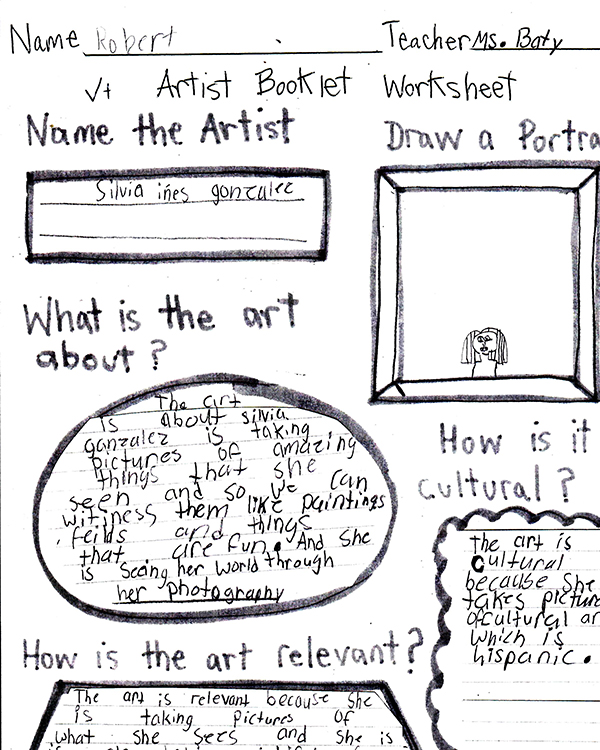
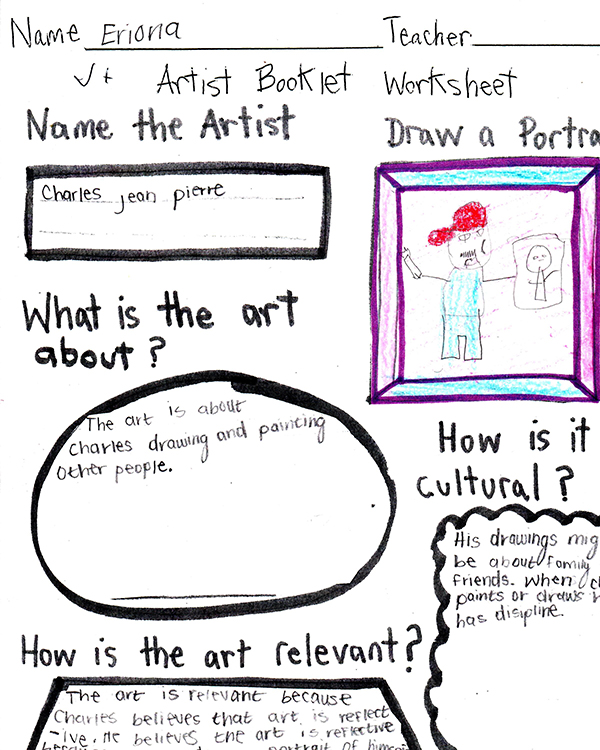

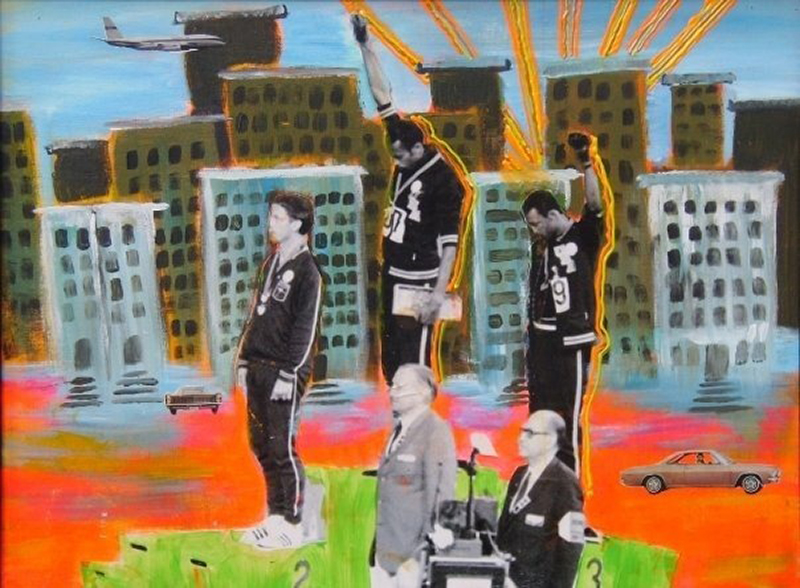
collage, 24 x 18 inches
private collection
image provided courtesy of the artist
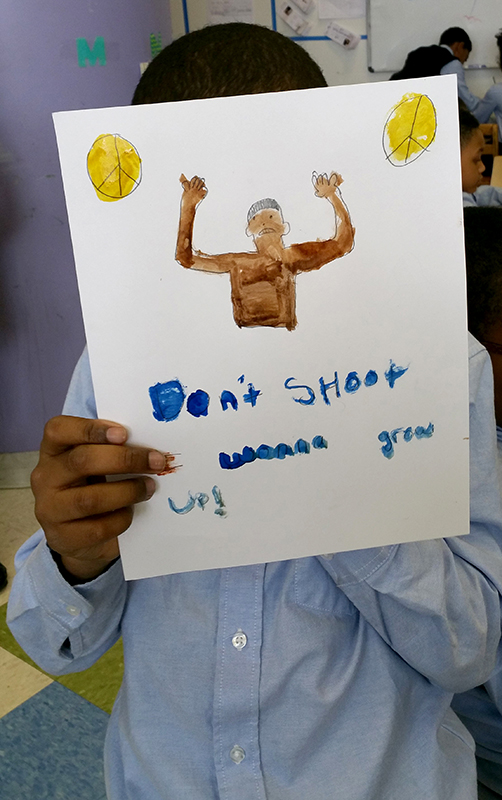
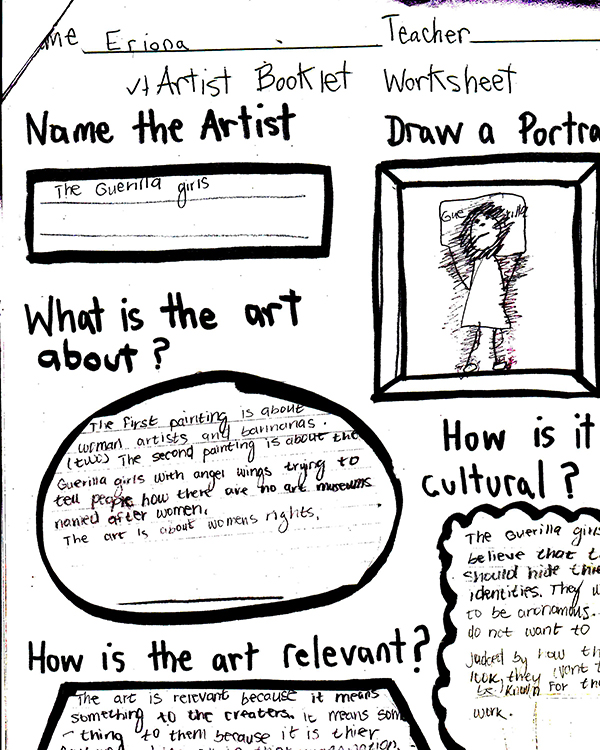
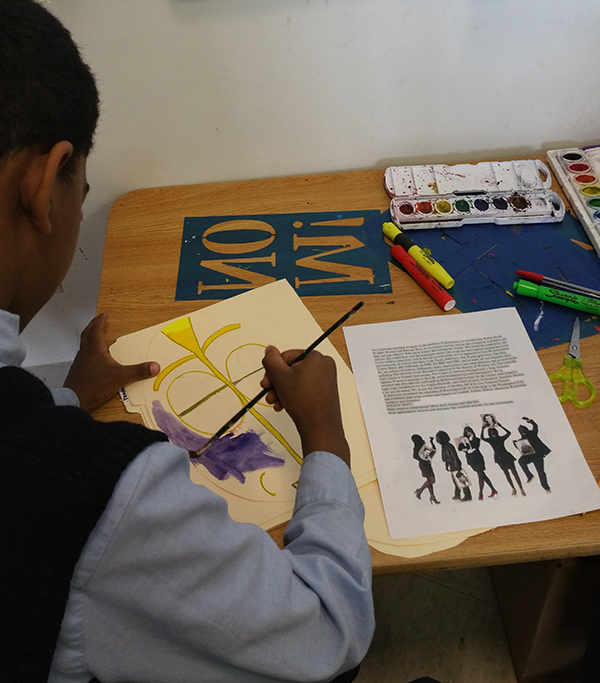
Materials + Supplies
- Artist Booklet Worksheets
- Bookbinding materials
- Markers
- Pencils
- Photocopies of pages for the book
- Paint
- Artwork prints
- Bio prints
MCA Connections
Our school has taken one field trip to the MCA to look and ask questions related to art, and to figure out what contemporary art is. This has led to lots of reflection on what many of the artists are thinking about in their work. Being curious about artmaking has been a large jumping-off aspect for our work.
Taking a field trip to the School of the Art Institute artist book library and visiting artist studios are also possible extensions to this project.
Resources
Forms and Worksheets:
Other Resources:
Wisdom Baty
Village Leadership Academy
Wisdom Baty is a Chicago-based artist, activist and educator whose work confronts ideas of representation and innovative, reflective art curriculum for youth of color. In the classroom she addresses critical issues rooted in cultural awareness and social justice from a global artistic perspective. She and Mr. Wadie’s 3rd-grade class created this project at Village Leadership Academy.
Wisdom reflects on her creative process:
As an art educator, I was constantly asking myself: Why is it so difficult to find workbooks and booklets that present works by artists of color and women from diverse cultures? Why is the art curriculum in education so Eurocentric? I love The Art Book for Children, with so many beautifully-printed artworks and engaging questions, presented in a fun and child-friendly manner. However, the overarching dilemma with this book is that the majority of the artists inside the book are white men, like most art history resources geared toward classroom use. So I came up with a solution: My students would create their own book that reflected them. My students and I have a stake in deciding what kind of art history is important. Having students involved in deciding what kind of artists and artworks would be included inside this workbook is empowering.
A major highlight during project implementation has been the process of acquiring artist permission to use their work inside the booklet. This produced some more “Aha” moments, the main consensus from artists being that this booklet was a great idea. Many of the artists I contacted thought that there was a severe lack of culturally relevant and diverse art books for children, especially ones that displayed contemporary artists. Introducing contemporary artists and their practices has brought on many moments of curiosity, laughs inside the classroom, and of course the lovely student “Aha” and “I get it.” My 3rd-grade students have been deconstructing artist bios, statements, and artwork. Currently we are continuing the process of looking at artists and the role that artwork serves.
This booklet serves as a visual arts educational tool about artists and artworks focusing on cultural and socially relevant issues. This is more of a contemporary art history activity booklet for children. The booklet is entitled Art Like Me because I believe many of my students will be able to relate to the artist themes and art practices included in the booklet.
